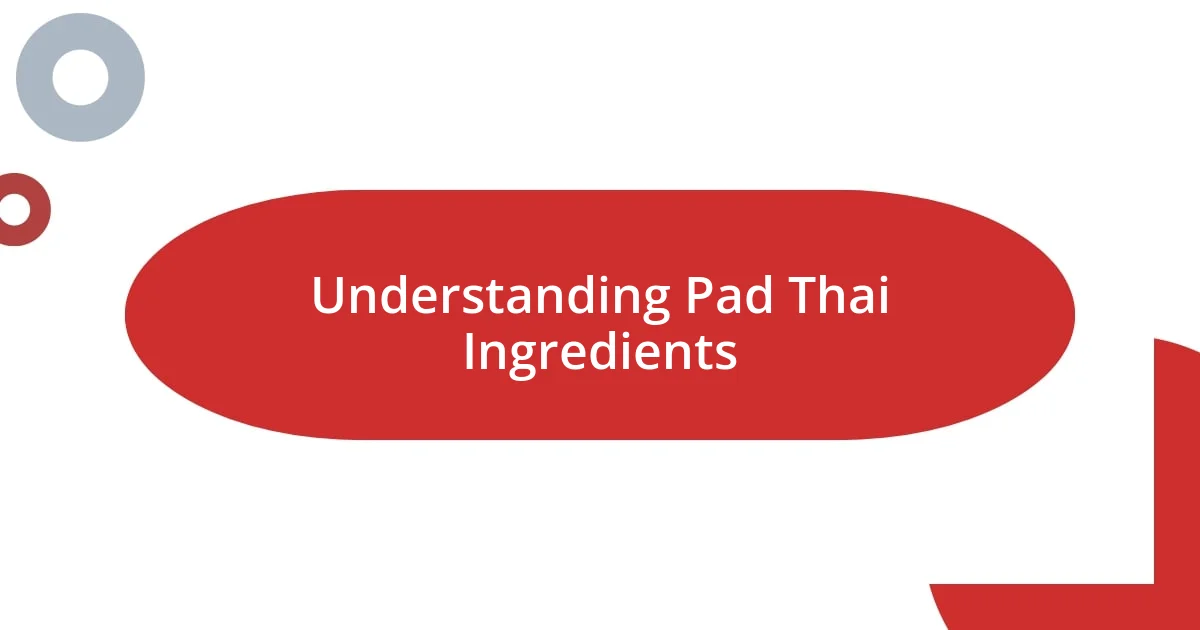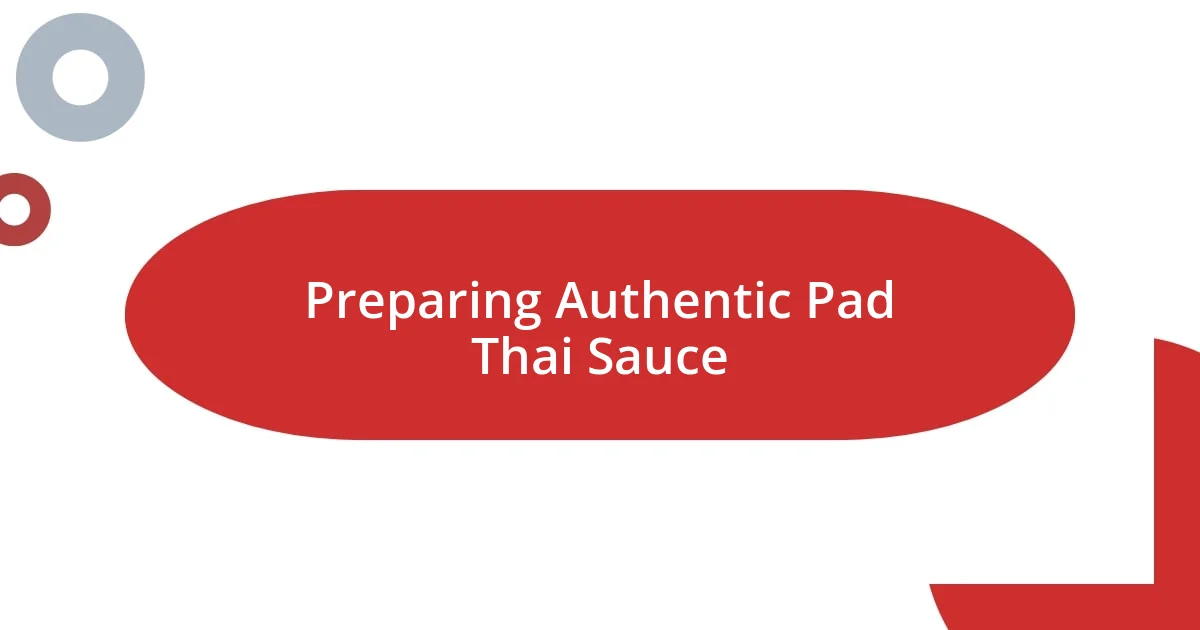Key takeaways:
- Choosing the right rice noodles is crucial; opt for flat, 1/4 inch wide noodles and consider using fresh for a softer texture.
- The authentic Pad Thai sauce requires a careful blend of tamarind paste, palm sugar, and fish sauce, with room for personal adjustments like adding chili powder.
- Presentation matters; garnishing with fresh herbs and serving with lime wedges enhances both the visual appeal and flavor customization of the dish.

Understanding Pad Thai Ingredients
When I first embarked on my journey to perfect pad Thai, I was surprised by the simplicity yet depth of its ingredients. At the heart of every great pad Thai are rice noodles, which add that iconic chewiness. Have you ever noticed how the texture transforms the whole dish? It’s like the noodles eagerly embrace every flavor around them.
Then, there’s the balance of proteins – shrimp, chicken, or tofu. Each choice takes the dish in a different direction. For me, the first time I tried it with tofu, I felt like I was discovering a whole new world of plant-based goodness. How do you feel about the different proteins in pad Thai? I find that tofu brings a wonderful creaminess that contrasts beautifully with the tangy tamarind sauce.
Don’t overlook the garnish! Fresh lime and crushed peanuts bring an irresistible crunch and brightness that elevate the dish. I vividly remember the first time I squeezed lime over my pad Thai; it felt like adding a burst of sunshine to each bite. It makes me wonder, what’s your favorite way to top off your pad Thai to enhance the flavors?

Selecting the Right Rice Noodles
Selecting the right rice noodles is crucial in achieving that authentic pad Thai experience. I’ll never forget the first time I mistakenly bought thick rice noodles, thinking they’d give my dish more bite. Instead, they became clumpy and lost that heavenly, chewy texture I craved. It was a real eye-opener for me, highlighting how pivotal the noodle choice is in the overall dish.
When choosing your rice noodles, consider the following tips:
– Width Matters: Look for flat rice noodles that are about 1/4 inch wide; they’re perfect for soaking up the flavors.
– Fresh or Dried: Fresh rice noodles lend a softer texture, while dried ones offer a firmer bite; I often lean towards fresh for that authentic experience.
– Soaking Technique: If using dried noodles, soak them in warm water until pliable before stir-frying to achieve the right consistency.
– Quality Counts: Opt for high-quality brands; it can make a world of difference in texture and taste.
Selecting the right rice noodles can truly be a transformative step in your pad Thai journey. Trust me, your taste buds will thank you!

Preparing Authentic Pad Thai Sauce
Preparing the authentic Pad Thai sauce is where the magic really begins. I remember the first time I whipped up my own sauce; the aroma of tamarind paste mixed with fish sauce wafted through my kitchen, and I felt a wave of excitement wash over me. The sauce’s perfect balance of sweet, salty, and tangy is essential to recreating that restaurant-quality experience at home. Have you ever tasted a Pad Thai where the sauce just seems to sing? For me, that’s what elevates the dish to greatness.
Creating the sauce requires a careful blend of key ingredients. Typically, the base consists of tamarind paste, sugar (preferably palm sugar), and fish sauce. My go-to ratio is about 3 tablespoons of tamarind paste, 2 tablespoons of sugar, and 2 tablespoons of fish sauce. It took me several attempts to perfect this balance, but once I did, I could taste the difference immediately. The flavors meld together beautifully, creating a rich sauce that coats the noodles just right.
A tip I learned along the way is to adjust the sauce to match your taste preferences; don’t shy away from experimenting! One time, feeling adventurous, I added a hint of chili powder for an extra kick, and it turned out to be a delightful surprise. What variations have you tried in your sauce preparation? Sometimes the smallest adjustments can make a world of difference.
| Ingredient | Purpose |
|---|---|
| Tamarind Paste | Provides the essential tangy flavor |
| Palm Sugar | Adds sweetness to balance the tanginess |
| Fish Sauce | Enhances umami and saltiness |
| Chili Powder (optional) | Adds a kick of heat, if desired |

Mastering Cooking Techniques
Mastering the cooking techniques for Pad Thai is essential if you want to really nail that dish. One technique I took some time to perfect was stir-frying at high heat. I still remember the first time I watched a street vendor skillfully toss ingredients in a sizzling wok—it was mesmerizing! I realized that the key is to have everything prepped and ready, so you can move fast and keep the heat high. Have you ever found your ingredients sticking to the pan? That’s usually a sign that your heat might be too low.
Also, timing is everything when it comes to adding ingredients to the wok. I learned through trial and error that if you add your proteins too quickly, they don’t cook evenly. I distinctly recall overcooking shrimp once, and they turned rubbery—definitely not the texture I was aiming for! Now, I add proteins first, then toss in vegetables, and finally, the noodles with sauce. This sequence not only enhances flavor but creates that beautiful, harmonious medley of textures.
Lastly, using a good wok was a game-changer. Initially, I underestimated how much it could impact the outcome. I bought a heavy stainless-steel pan thinking it’d work just fine, but it lacked that unique smoky flavor that comes from a well-seasoned wok. When I finally made that switch, the difference was remarkable! Do you have a preferred cooking vessel? Believe me, it can truly elevate your Pad Thai experience!

Personalizing Your Pad Thai Recipe
When it comes to personalizing your Pad Thai recipe, the beauty lies in tailoring it to your taste. I remember the first time I decided to experiment with proteins. Instead of sticking to chicken or shrimp, I threw in some crispy tofu, and it transformed the dish completely! The texture combined with the rich sauce created a delightful contrast that I hadn’t anticipated. Have you thought about what your favorite protein might be? It’s amazing how a simple change can lead to a whole new culinary adventure.
Another way to customize your Pad Thai is through the toppings. I’ve played around with different garnishes, and one of my favorites is crushed peanuts with a sprinkle of lime zest. It adds a vibrant pop that really brightens the dish. The first time I served this version at a dinner party, my friends couldn’t stop raving about it. I always encourage others to think beyond the basics—what would you add to elevate your Pad Thai? Your unique touches can make the meal truly yours.
Finally, don’t forget about the heat level; personalizing spice can be a game-changer. One evening, I dared to up my chili game and added fresh bird’s eye chilies. The result? An unforgettable punch that made every bite exciting. It made me appreciate how controlled heat can lead to layers of flavor. How do you like your spice? I find that adjusting the heat can really take the dish to new heights, making it an experience that’s distinctly your own.

Troubleshooting Common Issues
There are a few common pitfalls that many home cooks encounter while making Pad Thai. For instance, have you ever found your pad thai too dry or clumpy? I certainly have! I learned the hard way that the key to avoiding this is making sure you have enough sauce and that you’re adding it gradually as you stir-fry. The right amount of moisture makes all the difference in achieving that luscious, saucy texture we all crave.
If your Pad Thai turns out too salty, don’t panic; it happens to the best of us. I once overdid it with the fish sauce, and the dish was practically inedible. What worked for me was adding a bit of unsalted broth or water to balance it out. You can even introduce some extra veggies or noodles to absorb that saltiness. Have you considered how ingredient ratios can shift the overall flavor? It’s all about finding that perfect harmony.
Lastly, if you notice that your noodles aren’t soft enough or are sticking together, it might be time to reassess your soaking method. I remember mistakenly using boiling water to soften my rice noodles too quickly once. The result was an inconsistent texture that drove me nuts. I’ve since discovered that soaking them in warm water until just pliable before adding them to the wok allows for better control. How do you treat your noodles? A little patience goes a long way in ensuring they cook just right for the ultimate Pad Thai experience!

Serving and Presenting Pad Thai
When it comes to serving Pad Thai, presentation plays a crucial role in the overall dining experience. I’ve found that a colorful plate makes a significant impact; garnishing with fresh herbs like cilantro and Thai basil elevates the dish instantly. The first time I served it this way, I noticed my guests gravitating toward the vibrant colors—it’s like a feast for the eyes before the first bite! I often ask myself, how can I make my meal not just delicious but also visually appealing? The answer lies in those simple yet effective garnishes.
Plating techniques can also create a memorable impression. One of my favorite methods is to mound the noodles slightly to give the dish height, then drizzle some extra sauce on top. This creates a delicious cascade of flavors that beckons your guests to dig in. I remember serving it at a family gathering where everyone was so eager to taste it, they hardly waited for me to finish sharing my culinary journey! Have you considered how your plating could entice your loved ones? A bit of thoughtful arrangement can turn a simple meal into something astonishing.
Finally, serving Pad Thai with lime wedges not only adds a zesty brightness but also encourages guests to customize their experience with fresh acidity. I was once surprised when a friend insisted on squeezing an extra wedge over her portion—it just transformed the dish for her! Have you tried this interactive approach when serving? It can create a delightful moment of personal engagement where everyone can tweak the flavors to their liking, proving that there’s always room for a little personal touch in even the most traditional dishes.















